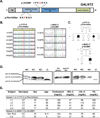Loss of Function of GALNT2 Lowers High-Density Lipoproteins in Humans, Nonhuman Primates, and Rodents
- PMID: 27508872
- PMCID: PMC5663192
- DOI: 10.1016/j.cmet.2016.07.012
Loss of Function of GALNT2 Lowers High-Density Lipoproteins in Humans, Nonhuman Primates, and Rodents
Abstract
Human genetics studies have implicated GALNT2, encoding GalNAc-T2, as a regulator of high-density lipoprotein cholesterol (HDL-C) metabolism, but the mechanisms relating GALNT2 to HDL-C remain unclear. We investigated the impact of homozygous GALNT2 deficiency on HDL-C in humans and mammalian models. We identified two humans homozygous for loss-of-function mutations in GALNT2 who demonstrated low HDL-C. We also found that GALNT2 loss of function in mice, rats, and nonhuman primates decreased HDL-C. O-glycoproteomics studies of a human GALNT2-deficient subject validated ANGPTL3 and ApoC-III as GalNAc-T2 targets. Additional glycoproteomics in rodents identified targets influencing HDL-C, including phospholipid transfer protein (PLTP). GALNT2 deficiency reduced plasma PLTP activity in humans and rodents, and in mice this was rescued by reconstitution of hepatic Galnt2. We also found that GALNT2 GWAS SNPs associated with reduced HDL-C also correlate with lower hepatic GALNT2 expression. These results posit GALNT2 as a direct modulator of HDL metabolism across mammals.
Copyright © 2016 Elsevier Inc. All rights reserved.
Figures






References
-
- Abou Jamra R, Wohlfart S, Zweier M, Uebe S, Priebe L, Ekici A, Giesebrecht S, Abboud A, Al Khateeb MA, Fakher M, et al. Homozygosity mapping in 64 Syrian consanguineous families with non-specific intellectual disability reveals 11 novel loci and high heterogeneity. European journal of human genetics : EJHG. 2011;19:1161–1166. - PMC - PubMed
-
- Folkersen L, van’t Hooft F, Chernogubova E, Agardh HE, Hansson GK, Hedin U, Liska J, Syvanen AC, Paulsson-Berne G, Franco-Cereceda A, et al. Association of genetic risk variants with expression of proximal genes identifies novel susceptibility genes for cardiovascular disease. Circulation. Cardiovascular genetics. 2010;3:365–373. - PubMed
-
- Fritz TA, Raman J, Tabak LA. Dynamic association between the catalytic and lectin domains of human UDP-GalNAc:polypeptide alpha-N-acetylgalactosaminyltransferase-2. The Journal of biological chemistry. 2006;281:8613–8619. - PubMed
MeSH terms
Substances
Grants and funding
LinkOut - more resources
Full Text Sources
Other Literature Sources
Molecular Biology Databases
Miscellaneous

